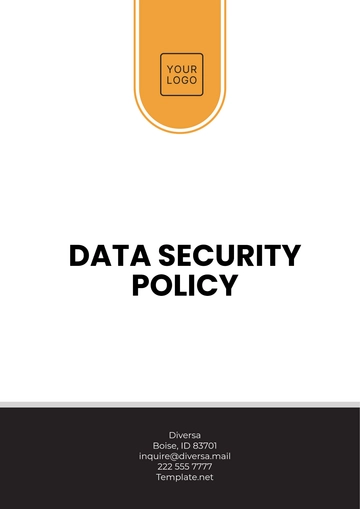Free Financial Services Security Policy

Effective Date: January 1, 2080
Version: 1.0
Approved by: [Your Name]
Next Review Date: January 1, 2081
1. Purpose
The purpose of this Financial Services Security Policy is to establish and maintain a secure environment for the protection of all sensitive financial data, personal information, and assets under the company's care. This policy is designed to mitigate risks, ensure compliance with relevant regulatory requirements, and safeguard the integrity of financial services operations.
2. Scope
This policy applies to all employees, contractors, vendors, and any third parties who access or handle financial data and systems within the organization. It includes, but is not limited to:
Financial transaction systems
Client accounts and data
Employee records
Financial reporting systems
3. Security Principles
The following principles guide the implementation of this security policy:
Confidentiality: Ensuring that sensitive financial data is accessible only to authorized individuals.
Integrity: Ensuring that financial data remains accurate and unaltered.
Availability: Ensuring that financial services and systems are available and functional when needed.
Accountability: Implementing controls to track and audit financial activities and transactions.
4. Roles and Responsibilities
Chief Information Security Officer (CISO): Oversee the implementation and management of security policies, strategies, and practices.
IT Security Team: Monitor, detect, and respond to security threats and vulnerabilities.
Employees: Adhere to security policies, procedures, and protocols to protect financial data.
Vendors/Third-Party Service Providers: Ensure security measures are in place and compliant with company policies when accessing or handling sensitive financial information.
5. Data Protection and Privacy
All financial data must be encrypted both at rest and in transit using industry-standard encryption methods.
Personal data must be protected in compliance with global data privacy regulations, including GDPR, CCPA, or any other applicable laws.
Financial data should only be retained for the period necessary to fulfill legal, regulatory, and business requirements.
6. Access Control
Authentication: Strong, multi-factor authentication (MFA) is required for access to financial systems.
Authorization: Access to financial data and systems should be granted based on the principle of least privilege.
User Roles: Clearly defined user roles and permissions should be established to control access to sensitive financial data.
7. Incident Response and Management
Reporting: Employees must immediately report any security incidents, breaches, or suspicious activities to the IT security team.
Response Plan: A documented incident response plan must be in place, detailing the steps to contain, investigate, and recover from a security breach.
Communication: A communication strategy should be in place to inform clients and stakeholders in the event of a security breach that affects their financial data.
8. Risk Management
Regular risk assessments should be conducted to identify and evaluate potential threats and vulnerabilities within the financial systems.
Risk mitigation strategies should be implemented to address identified risks and residual risks should be monitored and reviewed periodically.
9. Compliance
The company must comply with all applicable financial services regulations, including those from local, state, and federal authorities.
Regular audits must be conducted to ensure compliance with security policies and regulatory requirements.
Employees must receive training on compliance requirements and their role in protecting financial data.
10. Security Awareness and Training
Ongoing security training programs must be provided to all employees, contractors, and vendors to ensure they understand the importance of data security and how to recognize potential threats.
Employees should be trained in the proper handling of financial data, including how to avoid phishing attacks, social engineering, and other common security threats.
11. Physical Security
Physical access to areas where financial systems or sensitive data are stored must be restricted to authorized personnel.
Security measures, including surveillance cameras and access control systems, should be in place to protect physical assets.
12. Monitoring and Auditing
Financial systems should be continuously monitored for signs of unauthorized access, fraud, or other suspicious activities.
Regular audits should be performed to ensure that all security measures are functioning as intended and to assess the effectiveness of the security policy.
13. Policy Enforcement
Violations of this security policy may result in disciplinary action, including termination, legal action, or fines, depending on the severity of the breach.
All employees, contractors, and third parties must acknowledge and comply with this security policy.
- 100% Customizable, free editor
- Access 1 Million+ Templates, photo’s & graphics
- Download or share as a template
- Click and replace photos, graphics, text, backgrounds
- Resize, crop, AI write & more
- Access advanced editor
Create a secure financial environment with our Financial Services Security Policy Template. This editable and customizable template offers tailored security measures for financial institutions. Edit and adapt it easily using our Ai Editor Tool to align with your unique requirements. Start protecting your assets today with Template.net's professional security solution.
You may also like
- HR Policy
- Restaurant Policy
- Company Policy
- Accounting Policies and Procedures
- Website Policy
- Privacy Policy
- Safety Policy
- School Policy
- IT and Software Policy
- Law Firm Policy
- Construction Policy
- Interior Design Policy
- Travel Agency Policy
- Education Academic Policy
- Security Policy
- Real Estate Policy
- Expense Policy
- Software Policy





























